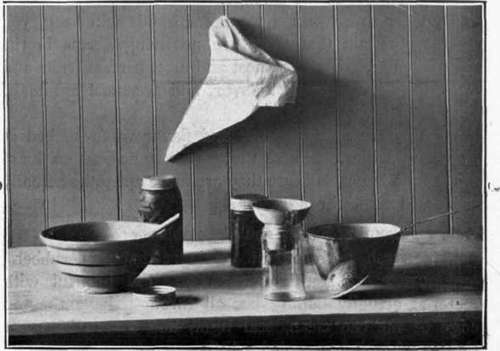Chapter XII. Canning
Description
This section is from the book "Hand-Book Of Household Science", by Juniata L. Shepperd. Also available from Amazon: Handbook of household science.
Chapter XII. Canning
Use a granite or porcelain kettle for cooking all acid fruits and vegetables. A wooden spoon is best for stirring.

Canning and Jelly Making
The first thing necessary is to prepare the cans. Wash them thoroughly with soapsuds, and, if need be, boil them in lye water. When jars and covers are perfectly clean and free from odors, fit each jar with cover and rubber, and let stand upside down with water in, that you may be sure they do not leak. When they are fitted, keep them together until they are used, but do not put covers on the jars as they are apt to smell when opened. When sugar is used in fruit, it should be put in just long enough before sealing to be melted, as it loses sweetness by cooking with fruit.
Both vegetables and fruits for canning should be perfectly mature, but not over ripe. They should be free from blemish, and cooked and canned as soon as possible after picking. After they become mature, they soon begin to deteriorate.
Prepare to take each fruit and vegetable when in season, and at its best. When getting ready for a day of canning, try to can the most perfect, and make marmalades or butters of the cullings.
In order to be sure that canned goods will keep, you must be certain that there are no living germs in the cans when sealed. The finest and most perfect fruits and vegetables have the best flavor, and are most apt to be free from germs.
Fruits have a better color and flavor when cooked in small quantities, because they are not cooked so long. They keep better, because they are more apt to be actually boiling hot all through.
Rule for Canning Fruits and Vegetables
Have fresh, perfect fruit. Be sure that jars, rubbers, and covers are sterilized and hot. Fill brimful with material actually boiling hot all through, have the top edge of the can clean, seal tight, and screw the cover tighter when it has cooled a little.
Pieplant is the first of the fruit kind to appear in the spring, and, on account of its pleasant acid taste, it is not unwelcome through the winter in shortcakes, pies and marmalades.
To Can Pieplant
Wash the stalks of pieplant, and, if old enough to have a tough skin, peel. Cut in pieces, and cook in a small amount of water until soft and thoroughly heated through. Sweeten or not, as you like, as this makes no difference with its keeping. Have a large pan of hot water on the stove, with an iron rack in the bottom of it for the cans to lie on. Let the water extend at least half way up the cans. Have the water boiling, and put the cans in it, each one with its rubber on, and its cover by its side. Lay the cans in the water so that water will be inside and out. When the fruit is cooked (in a separate kettle), raise a jar, empty the water into the pan, fill within half an inch of the top, wipe the edge clean, and finish filling to the brim with boiling water. Take the cover from the hot water, screw it on, and set the jar on a wet towel out of the draft. As it cools, put the cover down a little if you can. Be sure that the cans, as well as covers and rubbers, are sterilized, the contents boiling hot, and the covers on tight, for it is on these things that success depends. Pieplant may be cut into pieces, packed in jars that have been sterilized and cooled, and the contents then covered with water which has been boiled and cooled, and it is pretty apt to keep, if the work is done quickly, and the jar sealed at once; for the only chance for germs is on the pieplant itself. Pieplant may be also cut into pieces, put in hot sterilized jars, covered with boiling water, put in a pan of water in the oven, with support for the jars, and the covers screwed on after it is cooked some, but not enough to fall to pieces. This will look prettier than when broken up in cooking.
When fruit is scarce, some pieplant should always be canned while it is still young and tender. One part of pieplant with two parts of plums makes a fine-flavored fruit butter. Apples may be successfully mixed with pieplant in the same way.
Continue to:


